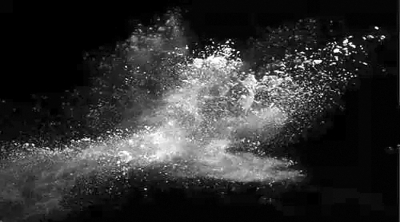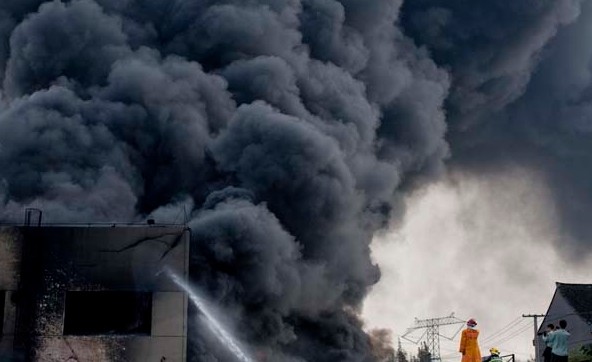Harsh and Hazardous Location lighting Manufacturer
[email protected] +86-25-85508029
Submit a Request
Why Boom Goes the Dust
On PVC, static electricity, and the myth of home shop dust explosions
One of the most enduring myths of home wood shops is the notion that PVC ductwork on your dust collector can lead to an explosion. The idea is that you have dust suspended in the ductwork, there's a static spark that ignites the dust, and BOOM! There's a massive explosion.
It's understandable why this misconception exists. After all, we've all heard of dust explosions in grain storage facilities. Based on that loose knowledge, you think "I have dust. And I can feel there's static electricity on the PVC pipes. Oh my, I could have a dust explosion ..."

Before getting into the details, let me set your mind at ease. There is absolutely no reasonable risk of this happening. There's not even a remote risk. It's so close to impossible that you're much better off building a large metal shield over your shop, because it's much more likely to get hit by a meteor than have a PVC-induced dust explosion. There has never, ever been a verified PVC static-caused dust explosion in a home wood shop. Not even one. Of course, you can't really prove anything by a lack of evidence, but the fact that we have no record of it ever happening tends to back up the science of why it's not a realistic risk. So just stop worrying about it.
Now, if you really want the details of why I think this is a needless concern and what you should really be worried about, read on ...
Getting the boom
First of all, we need to understand that getting dust to explode is very difficult. Researchers in the field have to work very hard to get dust clouds to ignite under very controlled lab conditions, using specially build sparking devices that don't use static electricity at all. In fact, static discharge may often get the blame for a dust explosion just because the investigators can't find any other reason.
Why does a dust cloud explode, anyway? Well, like most explosions, we have a material that not only burns, it burns very, very rapidly. A dust cloud takes a relatively small amount of material and vastly increases its surface area, suspending it within an oxidizer (oxygen), allowing it to all burn at once. A 2x4 may take 20 minutes to burn up and release its energy in your fireplace, but if you ignite the entire thing in a fraction of a second, the result is rather spectacular.
So, are all clouds of dust that dangerous? No, because it takes a very, very particular type of dust cloud to be flammable. The ignition has to spread across the cloud, so the particles have to be close enough, otherwise the particles right in the ignition source burn but it never gets any further. Just as the particles can't be too far apart, they also can't be too close together, since this removes the oxygen necessary for the rapid burn. So you have to get just the right "mixture" of fuel and air, just like a gasoline engine. And for dust clouds, the zone between too much and too little is extremely narrow, only a few thousandths of a pound per cubic foot.
Also, not any discharge will do. It needs to be a actual "spark", i.e. a concentrated point discharge, a diffuse discharge will not do the job. Also, it has to be a fairly "energetic" spark, a weak spark does nothing. Sparks happen when two points have a charge differential, i.e. there's more electrical charge in one thing than the other. The spark happens when the electrons jump across the gap. To be energetic, you need a lot of electrons making the leap, so the source point needs to give up a lot of charge very quickly.
(On a side note, it is possible for a large dust clouds to self-ignite because of internal static discharges. However, we're talking really large, way bigger than could ever exist in your ductwork)
Now that we understand what's required for an explosion, let's see if we have those conditions in the typical home wood shop.
Do you have the cloud?
Our first question should be: do we even have a dust cloud at all? Most likely not. Remember, we're talking about dust, an extremely fine powder. Most of what we produce in the shop is wood chips, far chunkier and unable to flash-burn. Therefore not a dust cloud, just a flying pile of chips.
OK, then, what about sanding? Yes, now we have dust that might be the right size. But do we have the quantity? Remember, we're now talking about a dust cloud that's constantly being sucked away by the dust collector at high velocity. To have any chance of hitting the cloud with a spark, we have to have a way of continuously replenishing the dust.
Let's assume a very small dust collector that only achieves 250 cfm. According to OSHA, the minimum amount for ignition would be 0.003 pounds per cubic foot. To achieve that, you'd have to generate 3/4 of a pound of sawdust per minute to maintain the dust cloud.
Let's say you're sanding a 12x12 piece of red oak. You'd have to sand off over 3/16" per minute to get that much sawdust! It's extremely unlikely you can generate that much sawdust. Maybe with a wide-belt sander, but then you'd have a much larger dust collector connected. A bigger system moves more air, so you have to make sawdust even faster. With a more typical 1000 cfm system, you'd have to sand off 3/4" per minute to generate the three pounds required! Just for fun, the next time you're sanding, sweep up a pile and weigh it to get some notion of how much three pounds of sawdust is.
So, the bottom line is that it's almost certain we're worrying about igniting something we don't even have.

Can you get the spark?
Let's assume the almost-impossible and say that we somehow get a dust cloud inside the ducts that's the correct composition and density. Where are we going to get the energetic spark?
The reason the PVC gets a static charge is from the sawdust rubbing against the PVC. There's nothing special about PVC, even metal ducts will take a charge. But metal ducts can be grounded to bleed away the charge. Just like PVC, an ungrounded metal duct will give you a static zap (ever been popped getting out of your car in the winter?). In fact, you'll get a far more intense jolt from a metal duct, because metal is a conductor. When you provide the grounding path with your finger, you provide the conduit for all the electric charge stored in the entire duct because it will freely move through the metal. Conductive materials will naturally assume a balanced charge throughout their entire structure.
PVC is different, because it's an insulator. Insulating materials have no problem with an unbalanced charge because electricity moves through them very slowly if at all. When you ground a static-charged PVC duct, you only drain the charge in the immediate vicinity of your finger, just a fraction of an inch. The rest of the charge will resist flowing to the ground point. Because of this, it's nearly impossible to get a "spark" discharge off an insulator like PVC. In fact, I challenge you to get even a tickle off PVC. I recently pumped a couple cubic feet of sawdust through my floor sweep, putting so much static on the PVC that the hairs on my arm were standing straight up at over 6 inches away from the duct. I grabbed my bandsaw's table, touched the duct and felt ... nothing.
That's also why wrapping a ground wire around a PVC duct is an exercise in futility. The only immediate effect will be to discharge a tiny portion of the surface charge right around the wire, nothing else. The charge on the inside wall and in the dust cloud (also an insulator) will be totally unaffected.
So, if you can cause a discharge (albeit weak) on the outside, what about the inside of the duct? The situation's a little different in there. Remember, the PVC became charged because the dust is rubbing on it. Well, that action is two-way, i.e. the dust is getting charged the same way. Not only at the same time, but the same type of charge and very near the same level. If we're looking to make a spark, just where would that happen? Both the cloud and duct are insulators that resist discharge. There's very little if any electrical charge difference between them. The bottom line is that even if you got a discharge (and they probably do happen), it would be even weaker and more diffuse than to a grounded point on the outside, nowhere near energetic and "spark-y" enough for ignition.
Therefore, it looks like not only do we lack the fuel, we don't even have the matches.
What's the real danger?
There are three realistic dangers in home dust collection, none of which has anything to do with PVC.
The most remote danger comes not from the duct, but the dust inside the filter. Not literally the filter, but the airspace inside. Here you have a much larger dust cloud that can stay around after the blower has stopped. The odds of having an explosion here are greatly higher than in the PVC ducts, but still extremely unlikely.
A much more likely danger (and something has has actually been documented) is ignition in the collection bin. Sucking up something metallic which then strikes the blower impeller (fan) can create a spark that goes into the pile of sawdust. This type of ember can smolder for hours before flaring up, taking your shop with it. The simple answer? Install a standard fire sprinkler above the collector.
The greatest danger from a home shop dust collector is poor filtration. Most (probably all) inexpensive dust collectors using filter bags still allow a tremendous amount of extremely fine dust to blow right through the filters and back into your lungs. What you really have is a large vacuum, not a dust collector.
